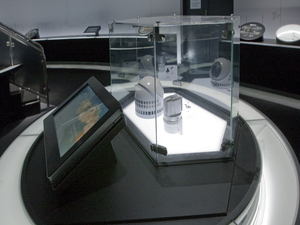Nagoya City Science Museum
TOP > Exhibition Guide > Keyword Search > Starting with "T" > telescope > Telescopes
Telescopes



Purpose of Exhibition
When it comes to a telescope, we may fancy that magnification is the most important property, but that is just not true. Magnification is nearly irrelevant how good and clear image it provides.
The performance of a telescope is basically determined by how much light it can collect (Light Gathering Power), and how fine details it can distinguish (Optical Resolution). These functions depend on telescope’s diameter, and so telescopes are getting larger and larger. For example, the aperture of Subaru Telescope at the summit of Maunakea, Hawaii is 8.2m (320in). Or, TMT now under construction has an aperture of 30m, as the name Thirty Meter Telescope indicates, which is the same size as this room.
This exhibit will compare and contrast the size of large telescopes using scale models and white frames hanging from ceiling, and show the features of each telescope on a computer terminal.
Additional Knowledge
[Large Telescopes in Japan]
Currently as of 2014, the largest telescope in Japan is the 200cm reflecting telescope at the Nishi-Harima Astronomical Observatory, in Hyogo Prefecture, which is the world largest telescope that is open to the public; you can look into the eyepiece with your own eye. Observations of scientific research with the near-infrared camera and spectroscopes are also conducted here.
The second largest in Japan is for research only: a 188cm diameter reflecting telescope at Okayama Astrophysical Observatory in Okayama Prefecture (a branch of the National Astronomical Observatory of Japan). April 23, 2009, it captured the afterglow of a gamma-ray burst, the most intense phenomenon known in the Universe. This explosion was later named “GRB090423”and the burster turned out to be approximately 13.1 billion light-years away from the earth, which means the explosion took place only 600 million years after the birth of the Universe. The telescope is still producing good results even though fifty years have passed since it was installed in 1960.
Hokkaido University has the third largest: Pirka, the 160cm reflecting telescope at Nayoro Observatory KITASUBARU. This telescope is available for public use as well as academic researchers.
The fourth largest in Japan are three 150cm reflecting telescopes: One belongs to Gunma Astronomical Observatory, in Gunma prefecture. In addition to the near-infrared camera and spectroscopes for research, it features a permanent eyepiece for the general public which allows visitors to look in the telescope with their own eyes. Another is at Hiroshima Astrophysical Science Center of Hiroshima. The telescope, named Kanata, is devoted to high-energy astronomical researches, collaborating closely with space telescopes such as Fermi gamma-ray satellite. The last one is in Tokyo; with this telescope National Institute of Information and Communications Technology is researching the optical communication technology with satellites using lasers and technology to detect very weak light from the Universe by collecting them.
This page was last edited on 15 June 2022.
http://www.nhao.jp/home.html
http://www.oao.nao.ac.jp/
http://www.astron.pref.gunma.jp/
Article by Astronomy Section
